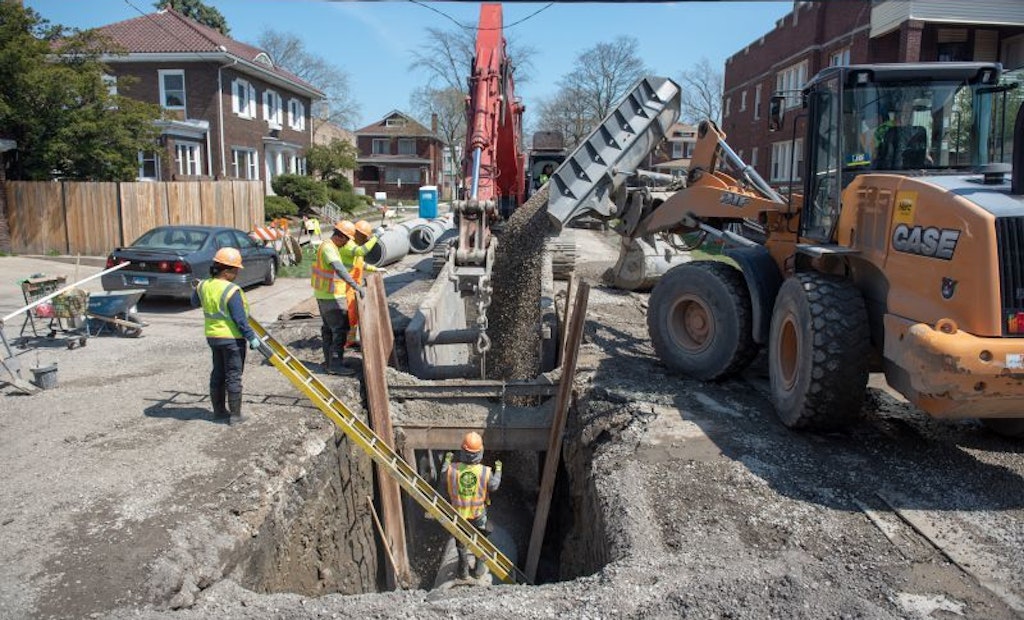Interested in Infrastructure?
Get Infrastructure articles, news and videos right in your inbox! Sign up now.
Infrastructure + Get AlertsBig, in that the Chicago’s Department of Water Management is capable of producing 2.1 billion gallons of potable water per day, serving 490,000 accounts and 5.3 million customers through over 4,000 miles of water mains. Drawing water from Lake Michigan, its two water treatment plants are among the largest in the world.
And the capital improvement plans and programs for this vast system are just as big. The department is in the midst of a 10-year campaign which aims to:
• Dramatically reduce the miles of old water mains — some of which date to the 1880s;
• Upgrade over 200,000 manually read water meters and add meters to unmetered accounts
• Convert three of the 12 pumping stations to sustainable status; and
• Investigate the potential to replace lead service lines throughout the city.
The total cost of these improvements is estimated at $6 billion when the plan is completed. To help fund these improvements, the Chicago city council — as well as the DWM’s partners and constituencies — unanimously agreed to incremental water rate increases totaling 75 percent over a four-year period from 2012-2016.
Water mains
Over half of the city’s water mains were installed in 1946 or earlier when the department began replacing them in 2012. The goal has been to install at least 90 miles of new pipe each year since, and DWM Commissioner Randy Conner says the installation rate has actually been increased because of efficiencies the department has developed over the period.
“Most of the old lines are ductile or cast iron — some reinforced concrete — although we’ve encountered some old wooden pipes, as well,” he says. “Average depth of the excavation is 6 feet and we’re using crawlers and backhoes and open-trench construction throughout the replacement project. Most of the new lines are ductile iron.” Diameters range from 6 inches for feeder lines to 48 inches for larger distribution mains.
While the department focuses on areas where leaks have been detected, using TriCorr ultrasonic devices and unusually high or constant flow rates noted on customer meters, much of the replacement has been in conjunction with other infrastructure projects like street reconstruction or utility replacement.
“We’ve become more efficient at replacing water mains as we’ve gone along,” Conner says. “We have been able to save money and increase the mileage of new pipe by grouping projects in specific areas of the city, and by leaving some of the old pipe in the ground and disconnecting it rather than trying to remove it.”
Chicago appears well on pace to meet its target of reducing and replacing over 1,000 miles of its pre-WWII pipe by 2021.
Water meters
The department’s meter replacement project is just as ambitious.
“We had been using manual-read meters before,” Deputy Commissioner Dr. Andrea Holthouse Putz says. “And although 80% of our revenue was metered, over 300,000 of our 490,000 accounts were nonmetered.” She says billing for non-metered accounts was estimated, based on the size of the building or house on the property and the number of occupants. Bills were sent every six months, in advance.
“All the nonmetered accounts are getting new Badger Orion AMR meters,” says Holthouse Putz. “These have 900-megahertz transmitters that we can drive by and read from the street. Customers appreciate being able to see actual and accurate usage,” she says. “Plus a red flag pops up if there’s a problem like a broken sewer or unusually high flow rate.”
A website (http://www.metersave.org) serves as clearinghouse of information.
As part of the meter installation process, DWM offers customers a free test for lead levels, a water pitcher and six water filters that are NSF-certified to remove lead if used correctly.
Lead service lines
The water produced by the DWM meets or betters all federal and state regulations, and the city aggressively tests to ensure water quality. Both water treatment plants add a phosphate blend to coat pipes and prevent corrosion. Still, there is the possibility that lead service lines and in-house plumbing could be leading to lead levels that exceed guidelines, particularly in homes built before 1986.
To that end, DWM has commissioned a study by the firm of CDM Smith to evaluate the total cost and multiple factors involved in replacing lead service lines connecting water mains to homes.
“We’re doing the study to get a better understanding of what’s going on in the city, and what are the technologies that might be employed, and the funding that might be available,” says Conner. Addressing this issue would make Chicago the largest city in the nation to explore a complete lead service line replacement program, and Conner estimates that costs to remove lead lines could be $4 to $8 billion over multiple decades.
“The Capital Plan is a huge investment in Chicago’s future,” says Conner. “It creates a foundation for our future growth, attracting new business and expanding our regional water distribution services.”






